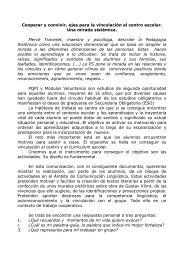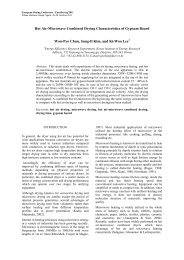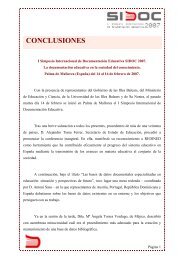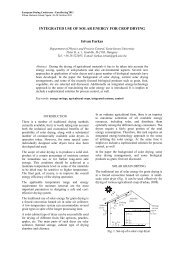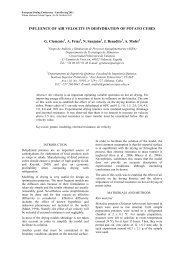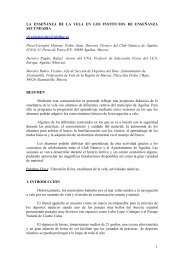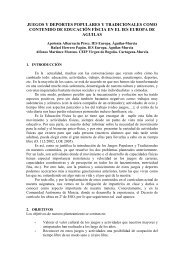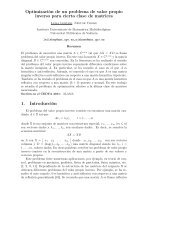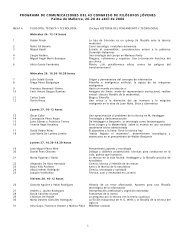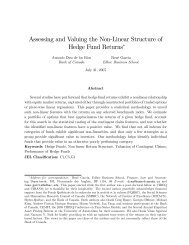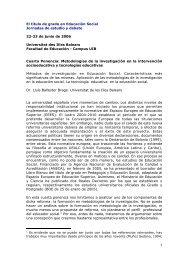Sistemas singulares de control positivos - UIB Congres
Sistemas singulares de control positivos - UIB Congres
Sistemas singulares de control positivos - UIB Congres
You also want an ePaper? Increase the reach of your titles
YUMPU automatically turns print PDFs into web optimized ePapers that Google loves.
<strong>Sistemas</strong> <strong>singulares</strong> <strong>de</strong> <strong>control</strong> <strong>positivos</strong><br />
A. Herrero, N. Thome<br />
Instituto <strong>de</strong> Matemática Multidisciplinar, Universitat Politècnica <strong>de</strong> València<br />
(ALAMA)<br />
aherrero@mat.upv.es,njthome@mat.upv.es<br />
Resumen<br />
Un sistema singular <strong>de</strong> <strong>control</strong> lineal discreto e invariante en el tiempo es un<br />
mo<strong>de</strong>lo <strong>de</strong> la forma:<br />
{<br />
Ex(k + 1) = Ax(k) + Bu(k)<br />
y(k) = Cx(k)<br />
don<strong>de</strong> E, A ∈ R n×n , B ∈ R n×m , C ∈ R p×n , k ∈ Z. En esta representación el<br />
vector x(k) ∈ R n es el vector <strong>de</strong> estados, u(k) ∈ R m es el vector <strong>de</strong> <strong>control</strong>es<br />
e y(k) ∈ R p es el vector <strong>de</strong> salidas. Un análisis profundo y actual <strong>de</strong> este tipo<br />
<strong>de</strong> sistemas se pue<strong>de</strong> encontrar en el libro <strong>de</strong> Duan [3] en el que se recogen<br />
a<strong>de</strong>más <strong>de</strong> sus propieda<strong>de</strong>s estructurales, un estudio sobre la regularización y<br />
la asignación <strong>de</strong> polos.<br />
Los sistemas <strong>singulares</strong> han sido aplicados en una gran variedad <strong>de</strong> áreas<br />
como, por ejemplo, para el diseño y <strong>control</strong> <strong>de</strong> circuitos eléctricos, procesos<br />
químicos, económicos, etc. [1, 5]. En algunas <strong>de</strong> estas situaciones surge la<br />
necesidad <strong>de</strong> que las variables <strong>de</strong>l sistema tomen valores <strong>positivos</strong> (o no negativos).<br />
Por ejemplo, cuando representan poblaciones, probabilida<strong>de</strong>s, consumo<br />
<strong>de</strong> bienes, <strong>de</strong>nsida<strong>de</strong>s <strong>de</strong> sustancias químicas, etc. El <strong>de</strong>sarrollo <strong>de</strong> mo<strong>de</strong>los<br />
teóricos que tengan en cuenta este requerimiento <strong>de</strong> positividad se conoce como<br />
el estudio <strong>de</strong> sistemas <strong>singulares</strong> <strong>positivos</strong> <strong>de</strong> <strong>control</strong>. En concreto, este tipo<br />
<strong>de</strong> sistemas garantiza salidas positivas ante estados y <strong>control</strong>es <strong>positivos</strong>. En<br />
relación al análisis <strong>de</strong> la positividad, una caracterización se pue<strong>de</strong> encontrar en<br />
[2]. Posteriormente, en [4], se han presentado otro tipo <strong>de</strong> condiciones necesarias<br />
y suficientes para matrices <strong>de</strong> índice 1. En este caso se hace uso <strong>de</strong> una<br />
<strong>de</strong>scomposición en bloques <strong>de</strong> las matrices <strong>de</strong>l sistema lo que pue<strong>de</strong> reducir consi<strong>de</strong>rablemente<br />
el tamaño <strong>de</strong>l problema. En este trabajo se utilizará la técnica<br />
<strong>de</strong> <strong>de</strong>scomposición en bloques para obtener condiciones que permitan garantizar<br />
la positividad <strong>de</strong>l sistema cuando las matrices consi<strong>de</strong>radas tengan índice<br />
superior a 1 completando así el estudio previo.<br />
Este trabajo ha sido parcialmente subvencionado por DGI MTM2010-18228<br />
and grant Universidad Politécnica <strong>de</strong> Valencia, PAID-06-09, Ref.: 2659.<br />
Sección en el CEDYA 2011: ALAMA Sesión especial: Análisis Matricial y<br />
Aplicaciones
Bibliography<br />
[1] R. Bru, J.M. Carrasco, L.C. Paraíba, Unsteady state fugacity mo<strong>de</strong>l by a dynamic<br />
<strong>control</strong> system, Applied Mathematical Mo<strong>de</strong>lling, 22 (1998), 484-494.<br />
[2] B. Cantó, C. Coll, E. Sánchez, Positive solutions of a discrete-time <strong>de</strong>scriptor system,<br />
International Journal of Systems Science, 39, 1 (2008), 81-88.<br />
[3] G.R. Duan, Analysis and <strong>de</strong>sign of <strong>de</strong>scriptor linear systems, Springer, 2010.<br />
[4] A. Herrero, A. Ramírez, N. Thome, An algorithm to check the nonnegativity of singular<br />
systems, Applied Mathematics and Computations, 189 (2007), 355-365.<br />
[5] J. Hofbauer, K. Sigmund, Evolutionary games and population dynamics, Cambridge<br />
University Press, 1998.




